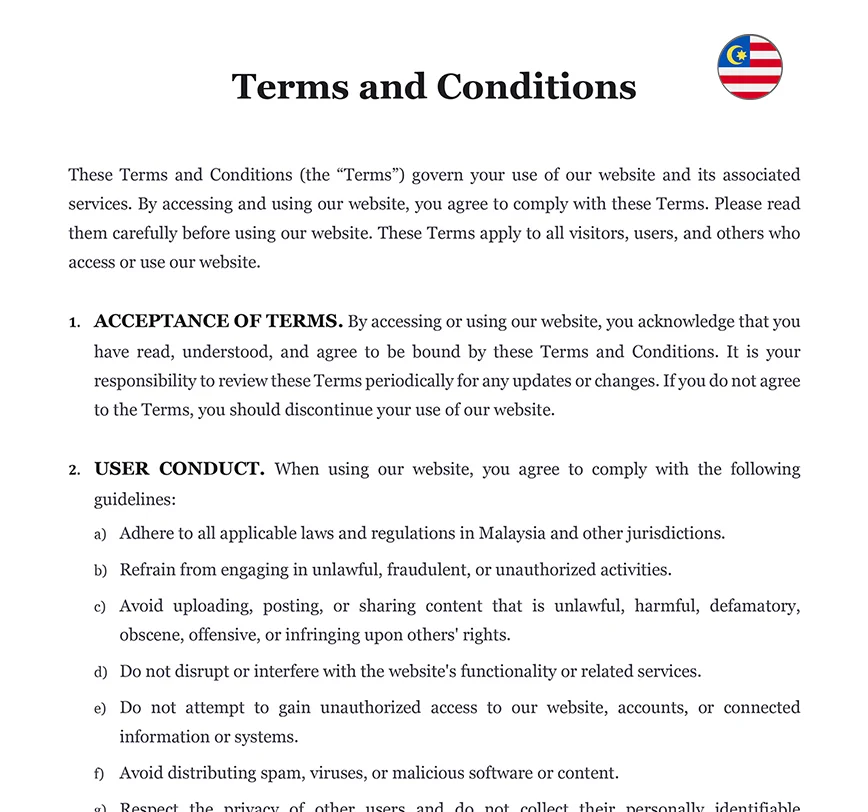Ready to use legal template
Drafted by experienced lawyers
Compliant with Malaysian law
Ready to use legal template
Drafted by lawyers
Compliant with Malaysian law
Home › Intellectual property › Terms and Conditions
Learn more about Website Terms and Conditions in Malaysia
In Malaysia, terms and conditions refer to a legal agreement that establishes the rights and responsibilities of parties involved in a transaction, service, or use of a product. It outlines the rules, obligations, and limitations that govern the relationship between the provider and the consumer. These terms and conditions can cover various aspects, such as payment terms, delivery arrangements, warranties, dispute resolution procedures, intellectual property rights, and privacy provisions. Themis Partner offers you an easy to edit Terms and Conditions drafted by lawyers to comply with the law in Malaysia.
📄 Related documents
Table of contents
What is a Terms and Conditions?
Terms and conditions, often abbreviated as T&C, refer to the legal agreement that outlines the rules, obligations, and rights governing the use of a product or service. It is a document that establishes the terms under which individuals or entities may interact with a company, website, or application. Typically found on websites, mobile apps, or printed materials, terms and conditions cover various aspects, including user responsibilities, intellectual property rights, disclaimers, privacy policies, refund policies, and dispute resolution mechanisms. These terms serve to protect the interests of both the provider and the user by setting clear expectations and defining the boundaries of the relationship between them. Users are usually required to agree to the terms and conditions before they can access or utilise the product or service, ensuring a mutual understanding and agreement between the parties involved.
Why use a Terms and Conditions?
Using T&C is essential for several reasons.
| ➤ Firstly, it establishes a legal framework that governs the relationship between a company and its users or customers. By clearly defining the rights, responsibilities, and obligations of both parties, it helps prevent misunderstandings and disputes. |
| ➤ Secondly, terms and conditions protect the interests of the company or service provider. It allows them to outline the acceptable use of their product or service, set limitations, and define liabilities. This helps safeguard their intellectual property, maintain the security of their systems, and mitigate potential risks. |
| ➤ Thirdly, terms and conditions can inform users about their rights, privacy policies, refund policies, and any disclaimers or limitations of liability. This transparency fosters trust and ensures that users are aware of the terms they are agreeing to. |
| ➤ Lastly, terms and conditions can serve as a legal defense in case of disputes, as they provide a written record of the agreed-upon terms and the user's acceptance of them. |
Overall, using terms and conditions is crucial for establishing a fair, transparent, and legally binding relationship between a company and its users or customers.
What should it include?
1. Acceptance of terms
A statement indicating that by using the product or service, the user agrees to the terms and conditions.
2. User obligations
Clear guidelines outlining the responsibilities and obligations of the user, such as prohibited activities, compliance with laws, and adherence to any usage policies.
3. Intellectual property rights
Information about the ownership and protection of intellectual property, including copyrights, trademarks, and any restrictions on the use of the company’s materials.
4. Privacy policy
Details about how user information is collected, stored, and used, including data protection practices and the use of cookies or tracking technologies.
5. Limitations of liability
A disclaimer stating that the company will not be held responsible for any damages, losses, or liabilities incurred through the use of the product or service.
6. Termination and suspension
Conditions under which the company can terminate or suspend access to the product or service, such as violation of terms, fraudulent activities, or security concerns.
7. Dispute resolution
Procedures for resolving disputes, including arbitration or mediation processes and the applicable jurisdiction for legal actions.
8. Updates and modifications
A statement indicating that the terms and conditions may be updated or modified by the company, and how users will be notified of any changes.
9. Governing law
The governing law that applies to the terms and conditions, specifying the jurisdiction where any legal disputes will be resolved.
10. Severability
A provision stating that if any part of the terms and conditions is deemed invalid or unenforceable, the remaining provisions will still remain in effect.
ℹ️ It is important to note that this is not an exhaustive list, and the specific elements included in terms and conditions may vary depending on the nature of the product or service and legal requirements in different jurisdictions.
How does it protect businesses and consumers?
T&C, along with a Privacy Policy, play a crucial role in protecting both businesses and consumers. For businesses, these legal documents provide a layer of protection by clearly outlining the rights and obligations of all parties involved. They establish guidelines for acceptable use, define limitations of liability, and safeguard the company’s intellectual property. By including a privacy policy within the terms and conditions, businesses can also ensure that user information is collected, stored, and used in a transparent and secure manner, respecting the privacy rights of consumers. This builds trust and confidence among consumers, who can review the privacy policy to understand how their data will be handled. Furthermore, these documents serve as a legal defense in case of disputes, as they provide a written record of the agreed-upon terms and the user’s acceptance of them. Overall, terms and conditions, coupled with a privacy policy, promote a fair and mutually beneficial relationship between businesses and consumers, fostering trust, protecting rights, and mitigating potential risks.
How does it outline intellectual property rights?
It play a critical role in outlining and protecting intellectual property rights. This section of the agreement clarifies the ownership and usage of intellectual property assets such as copyrights, trademarks, patents, and trade secrets. It specifies that the company or service provider retains exclusive ownership of their intellectual property and prohibits users from infringing upon these rights. It may include provisions that restrict users from reproducing, modifying, distributing, or using the company’s intellectual property without explicit permission. By clearly stating these rights and restrictions, the document helps prevent unauthorized use, protect the company’s valuable assets, and ensure that users understand their limitations in accessing and utilising the intellectual property associated with the product or service. This provision promotes respect for intellectual property rights and establishes a framework for the lawful and proper use of such assets.
What are the consequences of non-compliance?
| ➤ For users, the consequences may include the suspension or termination of their access to the product or service, loss of privileges or benefits, or even legal action in severe cases. |
| ➤ Businesses, on the other hand, may suffer repetitional damage, loss of trust from users or customers, and potential legal repercussions. |
| ➤ Non-compliance can also result in financial consequences, such as fines, penalties, or liability for damages caused by the violation. |
| ➤ Additionally, non-compliance may impact the overall security and integrity of the product or service, potentially exposing users' personal information or data to risks. |
What if I don’t have a Terms and Conditions
If you don’t have the agreement for your product or service, it can leave you and your users exposed to various risks and uncertainties. Without clearly defined terms, there may be ambiguity regarding the rights, responsibilities, and limitations associated with the use of your offering. This can lead to misunderstandings, disputes, and potential legal issues. In the absence of terms and conditions, it may be challenging to protect your intellectual property, establish usage guidelines, or address privacy concerns adequately. Moreover, not having the agreement can undermine the professional image of your business, as users may perceive a lack of transparency and accountability. It is strongly recommended to create and implement a comprehensive document to protect both your business and your users, establish clear expectations, and mitigate potential risks.
SPECIAL OFFER
eCommerce
5 Document Package
Essential website/app policies for online business in Malaysia
Terms and ConditionsTemplate (.docx)
Easy and quick to customize
310 client reviews (4.8/5) ⭐⭐⭐⭐⭐
Share information
Why Themis Partner ?
Make documents forhundreds of purposes
Hundreds of documents
Instant access to our entire library of documents for Malaysia.
24/7 legal support
Free legal advice from our network of qualified lawyers.
Easily customized
Editable Word documents, unlimited revisions and copies.
Legal and Reliable
Documents written by lawyers that you can use with confidence.




